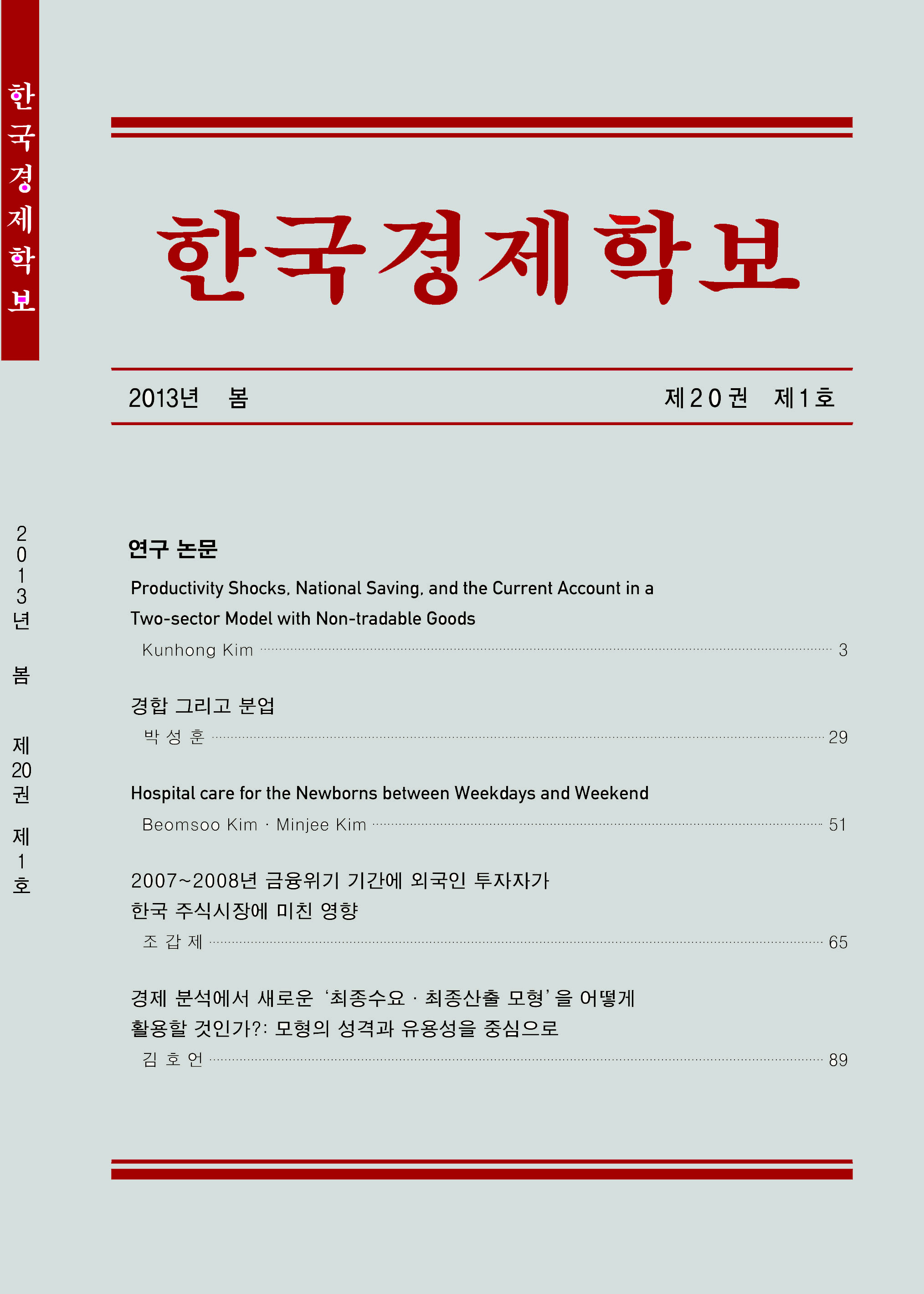
한국경제학보 제 23권, 제 2호 (2016년 가을)
Yong-Ju Lee
Pages 149-163
-
Abstract ( Eng | Kor ) || PDF
- This paper considers a model of contest between two asymmetric
agents in which reputation effects work in different directions. If
David wins, he gains substantial fame, and he has nothing to lose
but his effort even if he loses. By contrast, it is just a natural
outcome for Goliath to win, but if he loses, then he faces
substantial shame. We characterize the conditions for a unique
pure-strategy Nash equilibrium and conduct comparative statics to
examine how efforts and expected payoffs respond to variations
in contest parameters. From this analysis, we understand the
structure of interactions between fame, shame, ability, and effort
in the contest.
- 다윗과 골리앗의 경쟁
이용주
본 논문은 경기자간의 평판효과가 다른 방향으로 작용하는 비대칭적 경쟁을 모형화한다. 능력이 뒤쳐지는 다윗의 경우, 경쟁에서 승리하면 엄청난
명성을 얻게 되지만 지더라도 잃을 것이 거의 없다. 반면, 골리앗의 경우, 이기는 것은 당연한 결과로 여겨지지만, 만약 지게 되면 엄청난 치욕에 직면하게
된다. 본 논문은 이러한 비대칭적 상황에서 유일한 순수전략 내쉬균형이 존재하게 되는 조건을 구하고, 비교정학을 통해 파라미터의 변화에 따른 노력수준과 기대효용의 변화를 살펴본다.
이러한 분석을 통해 명성, 능력, 치욕과 노력수준간의 상관관계 구조를 직관적으로 이해하게 된다.
정민수
Pages 165-197
-
Abstract ( Eng | Kor ) || PDF
- Continuous-time Regression with
Nonstationary Error and the Comovement
of Stock Indices
Minsoo Jeong
We study the asymptotic properties of the continuous-time
regression in the presence of nonstatioinary error. Choi, Hu and
Ogaki (2008) have already well studied the case of I(1) processes
in discrete time. However, contrary to I(1) processes, there arise a
variety of situations when the model is in continuous time. In
continuous-time regression, we verify that both the OLS (ordinary
least squares) and GLS (generalized least squares) estimators may
or may not achieve the consistency, depending on the property of
the processes. We establish detailed conditions for the consistency
of the estimators in each case. Furthermore, we apply our
regression model to the stock indices of Korea and the US, to show
that the cointegration or return analysis may not fully characterize
the comovement of the stock indices.
- 본 연구에서는 연속시간 회귀모형에서 오차항이 정상성(stationarity)을
갖지 않는 경우의 추정량에 대해 분석한다. 이산시간 I(1) 과정의 경우 이미 Choi, Hu and Ogaki(2008)에서 다루었지만, 연속시간 모형은 단순한
I(1)을 기준으로 분석한 결과와는 다르게 모형의 특성에 따라 상이한
결과들이 다양하게 나타난다. 연속시간 모형은 이산시간 모형과는 달리 조건에 따라 OLS(ordinary least squares) 추정량이 일치성(consistency)을 갖기도 하고 GLS(generalized least squares)
추정량이 비일치성을 갖는 경우도 존재하게 되는데, 본 연구에서는 두 추정량이 일치성을 지닐 조건을 각각 도출하고 각 조건들의 의미를 살펴본다.
또한 한국과 미국의 주가지수 동조화 분석에 본 연구의 회귀모형을 적용하여, 기존의 공적분(cointegration) 분석이나 수익률모형 분석은 시계열의 추세적인 연관성을 설명하는데 충분하지 않을 수도 있음을 보인다.
장근호
Pages 199-240
-
Abstract ( Eng | Kor ) || PDF
- Investment Shocks in Korea's
Business Cycles
Keunho Jang
This paper reinvestigates the role of investment shocks in
accounting for business cycles based on the model of Justiniano,
Primiceri, and Tambalotti (2011) and analyzes them empirically
using post-2000 Korea's data. Estimation results show that shocks
to marginal efficiency of investment play much more important
roles rather than investment-specific technology shocks reflecting
real factors. Due to frictions such as countercyclical price markup,
shocks to marginal efficiency of investment successfully generate
co-movements between endogenous variables such as output,
consumption, investment and hours, and their impacts on business
cycles are greatly amplified as well. Meanwhile, estimated shocks
to marginal efficiency of investment are correlated with both firms'
financing conditions and financial and foreign exchange market
conditions. Hence, it is inferred that a significant part of business
cycles in Korea is attributal to financial conditions influencing
firms' investments for the post-2000 era.
- 본고에서는 기존의 경험적 연구에서 제한적이라고 알려져 왔던 경기변동에서의 투자충격의 역할을
Justiniano, Primiceri, and Tambalotti(2011)의 모형에 근거해서 재검증하고 2000년 이후 한국 자료를 통해
실증분석을 하였다. 모형의 추정결과, 실물적 요인의 투자특유기술충격보다는 투자한계효율충격의 경기변동에서의 역할이 크게 나타났다. 경기역행적
가격마크업 등 마찰요인으로 인해 투자한계효율충격은 생산, 소비, 투자, 노동시간 등 내생변수들의 공행성을 잘 나타내며 동 충격이 경기변동에 미치는 영향력도 크게 증폭되는 것으로 드러났다. 한편, 투자한계효율충격은
기업의 차입여건, 금융?외환시장 상황과 관련이 높은 것으로 드러났다. 따라서 2000년 이후 우리나라의 경기변동은 기업의 투자에 영향을 주는 금융여건의 변화에 크게 기인한 것으로 유추할 수 있다.
조갑제
Pages 241-268
-
Abstract ( Eng | Kor ) || PDF
- The Effects of House Price and Household
Debt on Consumption
Gab-Je Jo
This paper empirically investigates the effects of interaction
between house price and household debt on household consumption
in Korea, using macroeconomic data for 2003-2015. I have utilized
the cointegration test, the vector error correction analysis, the
Granger causality test, the impulse response function and the
variance decomposition test. The estimation results showed that,
in the situation of high household debt, there was significant
negative effect of house price on consumption. These results
suggest that ‘wealth effect’, which means the rise in house price
lift household consumption, is not found when the ratio of
household debt to income is high.
- 본 연구에서는 2003-2015년 기간의 거시적 시계열 자료를 활용하여 주택가격과 가계부채가 복합적으로 가계소비에 미치는 장단기적 영향에
관하여 실증분석하였다. 이를 위해 공적분 분석과 벡터오차수정모형에 의한
Granger 인과관계, 충격반응함수 및 분산분해분석을 활용하였다. 분석결과, 가계부채가 소득 대비 높은 상황에서는 주택가격의 상승은 장단기적으로
가계소비의 증가를 위축시키는 작용을 하는 것으로 나타났다. 이러한
분석결과는 주택가격의 상승이 가계소비를 견인한다는 ‘부의 효과’가 가계부채가 높은 상황에서는 발견되지 않는다는 논거를 제공한다.
The Korean Journal of Economics, Vol. 23, No. 2 (Autumn 2016)


